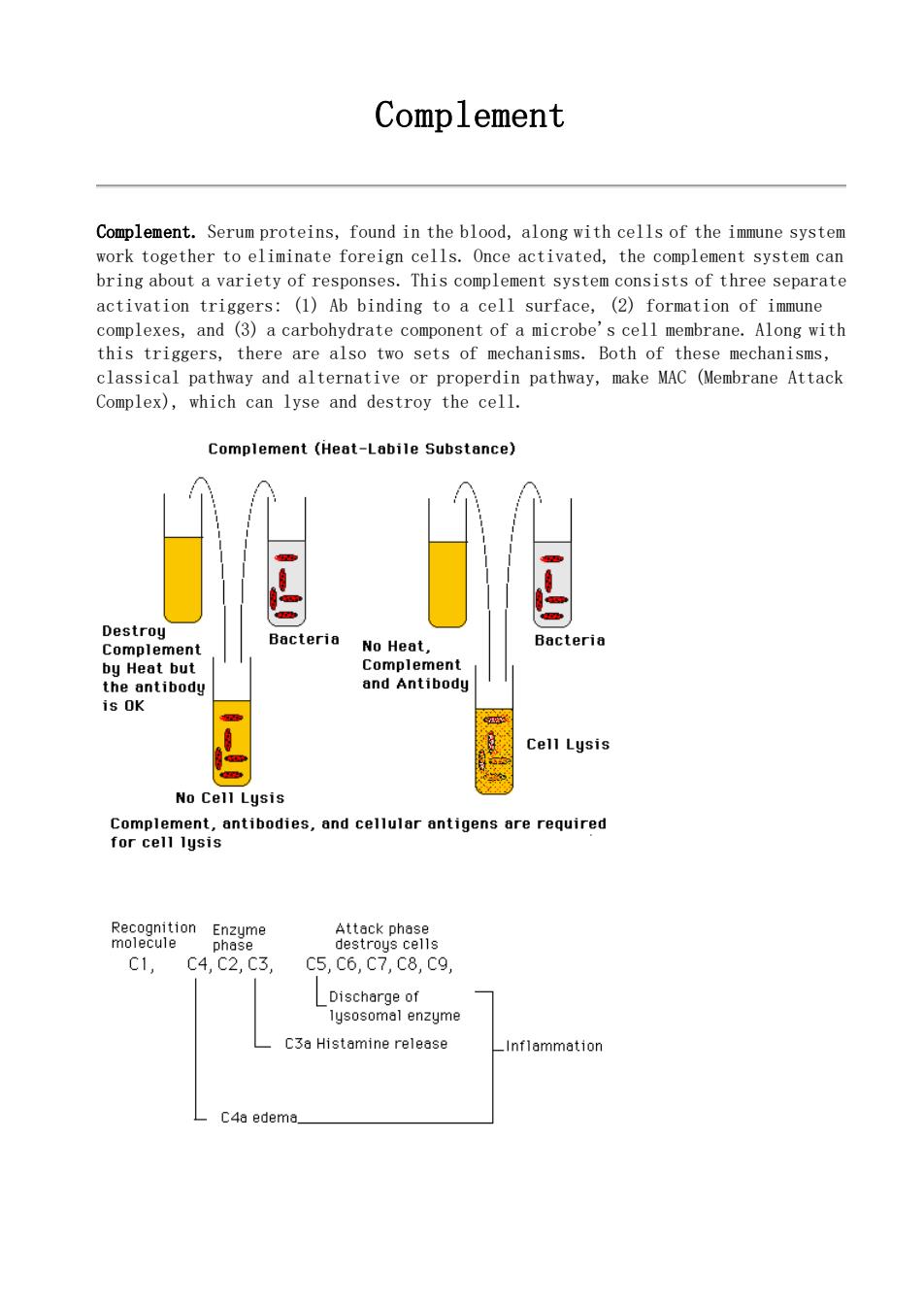
Complement Complement.Serum proteins,found in the blood,along with cells of the immune system work together to eliminate foreign cells.Once activated,the complement system can bring about a variety of responses.This complement system consists of three separate Along with this triggers,there are also two sets of mechanisms.Both of these mechanisms, classical pathway and alternative or properdin pathway,make MAC (Membrane Attack Complex),which can lyse and destroy the cell. Complement(Heat-Labile Substance) Destroy No Heat, by Heat but nent Cell Lysis No Cell Lysis Complement,antibodies,and cellular antigens are required for cell lysis C1, C4,C2,C3 C5,C6,C7,C8,C9 Discharge of ysosom al enzyme C3a Histamine release _Inflammation C4a edema
Complement Complement. Serum proteins, found in the blood, along with cells of the immune system work together to eliminate foreign cells. Once activated, the complement system can bring about a variety of responses. This complement system consists of three separate activation triggers: (1) Ab binding to a cell surface, (2) formation of immune complexes, and (3) a carbohydrate component of a microbe's cell membrane. Along with this triggers, there are also two sets of mechanisms. Both of these mechanisms, classical pathway and alternative or properdin pathway, make MAC (Membrane Attack Complex), which can lyse and destroy the cell
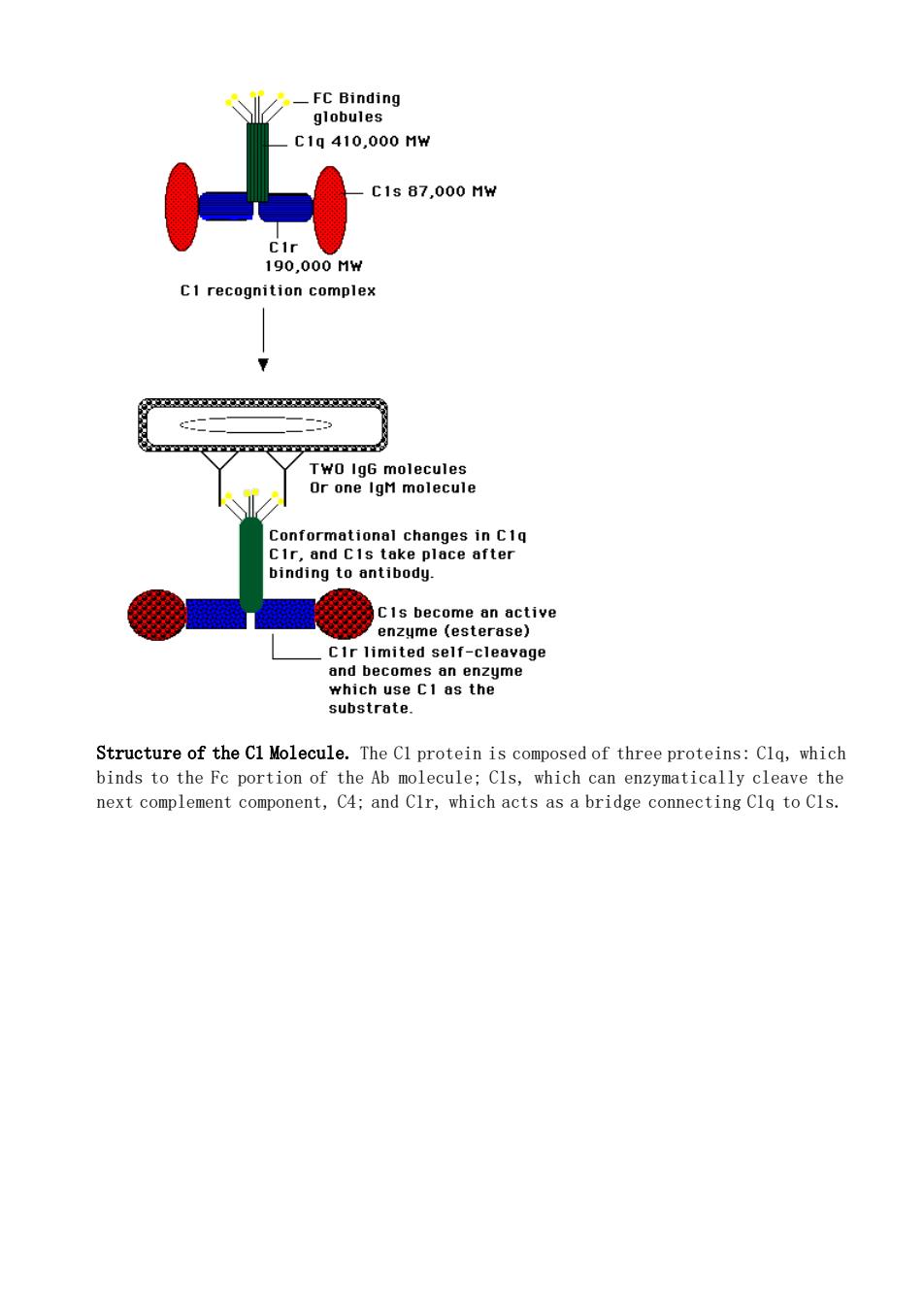
-C1q410,0001w -C1s87.000Hw 190.000Hw CI recognition complex Tw laG molecules Or one IgM molecule binding to antibody. CIs become an active enzyme(esterase) substrate. Structure of the Cl Molecule.The Cl protein is composed of three proteins:Clq,which binds to the Fc portion of the Ab molecule;Cls,which can enzymatically cleave the next complement component,C4:and CIr,which acts as a bridge connecting Clq to Cls
Structure of the C1 Molecule. The C1 protein is composed of three proteins: C1q, which binds to the Fc portion of the Ab molecule; C1s, which can enzymatically cleave the next complement component, C4; and C1r, which acts as a bridge connecting C1q to C1s

nitial r of the classical ent path W9wg999W9ggW99¥¥yygW9W99g99 C4b Ca C3b C3h Mg C2b C3a Opsonizing activity ct 80.00 3 C1 esterase c2 115,000 C1s -Enzymatic phase- erminal reactions of the classical complement pathwa MAC 8163.68079.000Mw -Enzymatic phase十 Attack phase-
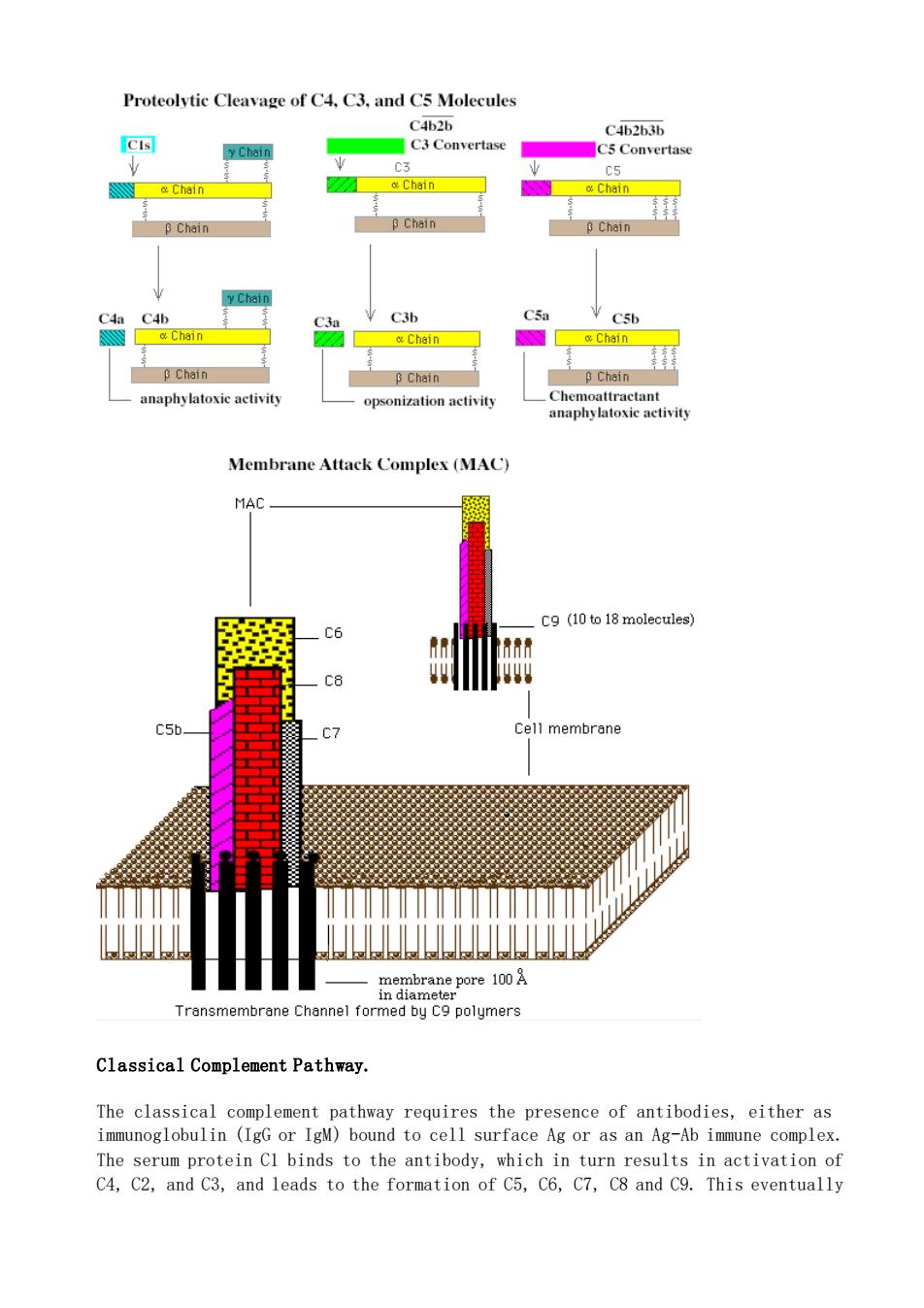
Proteolytie Cleavage of C4.C3.and C5 Molecules c国 C3 Convertase 462h3 Y Chain o Chain Chain a Chain B Chain anaphylatoxic activity opsonization activity Membrane Attack Complex (MAC) 1A C9 (10 to 18 molecules) membrane membrane pore10 Transmembrane Channel formed by C9 polymers Classical Complement Pathway. The classical complement pathway requires the presence of antibodies,either as immunoglobulin (IgG or IgM)bound to cell surface Ag or as an Ag-Ab immune complex The serum proteinCl binds to the antibody,which in turn results in activation of C4,C2,and C3,and leads to the formation of C5,C6,C7,C8 and C9.This eventually
Classical Complement Pathway. The classical complement pathway requires the presence of antibodies, either as immunoglobulin (IgG or IgM) bound to cell surface Ag or as an Ag-Ab immune complex. The serum protein C1 binds to the antibody, which in turn results in activation of C4, C2, and C3, and leads to the formation of C5, C6, C7, C8 and C9. This eventually
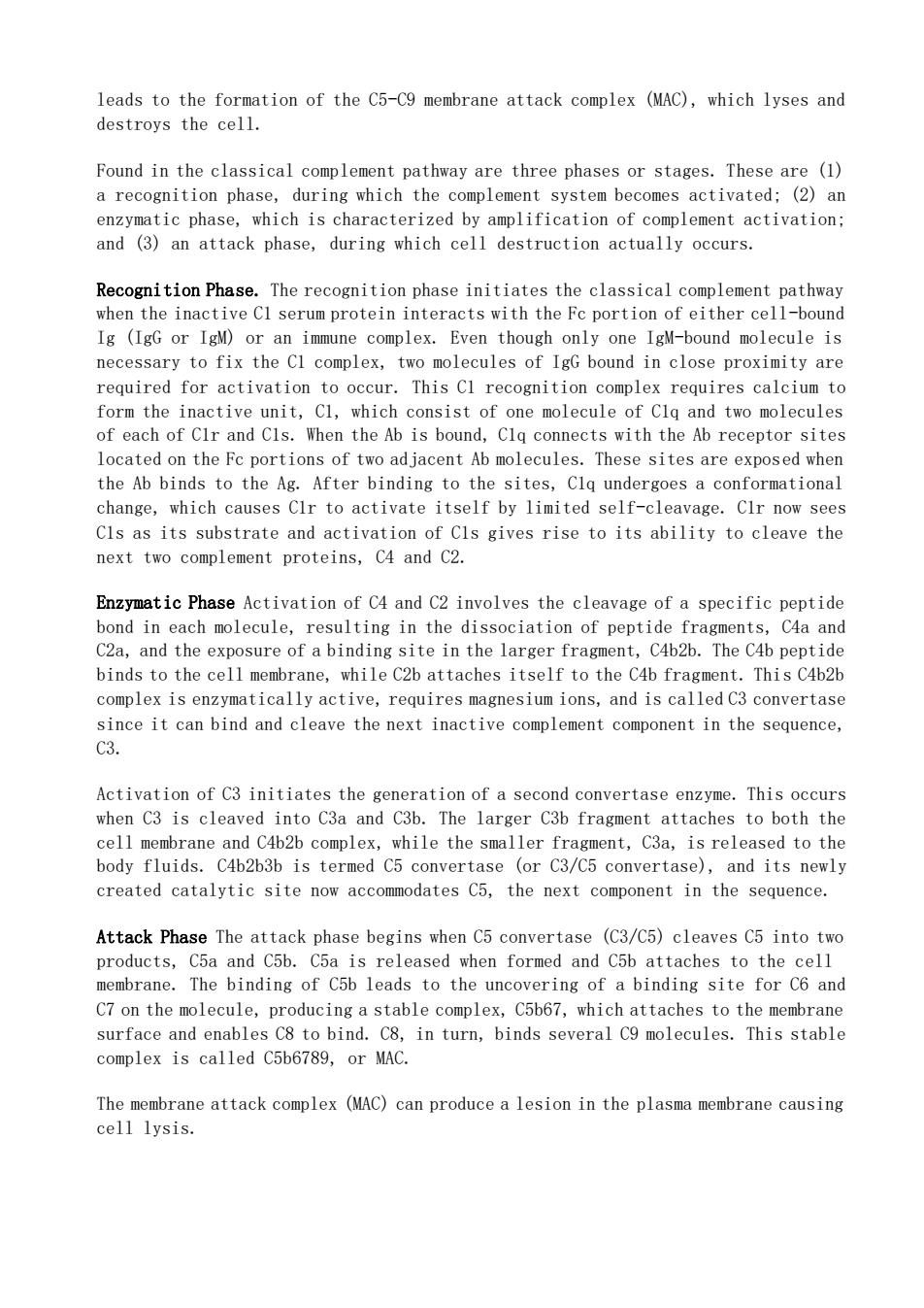
leads to the formation of the C5-C9 membrane attack complex (MAC),which lyses and destroys the cell. Found in the classical complement pathway are three phases or stages.These are (1) a recognition phase. during which the complement system becomes activated:(2)an enzymtic phase,which is characterized by amplification of complement activation: and (3)an attack phase,during which cell destruction actually occurs. Recognition Phase.The recognition phase initiates the classical complement pathway when the inactive Cl serum protein interacts with the Fc portion of either cell-bound Ig (IgG or IgM)or an immune complex.Even though only one IgM-bound molecule is necessary to fix the Cl complex,two mole ecules of IgG bound in close proximity are required for activation to occur.This Cl recognition complex requires calcium to form the inactive unit,Cl,which consist of one molecule of Clq and two molecules of each of Clr and Cls.When the Ab is bound,Clq connects with the Ab receptor sites located on the Fc portions of two adjacent Ab molecules.These sites are exposed when the Ab binds to the Ag.After binding to the site Clq undergoes a conformational change,which causes Clr to activate itself by limited self-cleavage.CIr now sees Cls as its substrate and activation of Cls gives rise to its ability to cleave the next two complement proteins,C4 and C2. Enzymatic Phase Activation of C4 and C2 involves the cleavage of a specific peptide deee ren the disociation or ents, C4a and osure of a binding site in the larger fragment The C4b peptid binds to the cell membrane,while C2b attaches itself to the C4b fragment.This C4b2 complex is enzymatically active,requires magnesium ions,and is called C3 convertase since it can bind and cleave the next inactive complement component in the sequence, ctivation of c3 initiatess the ronerati n C3 is cleaved cell membrane and C4b2b complex,while the smaller fragment,C3a,is released to the body fluids.C4b2b3b is termed C5 convertase (or C3/C5 convertase),and its newly created catalytic site now accommodates C5.the next component in the sequence. Attack Phase The attack phase begins when C5 convertase (C3/C5)cleaves C5 into tw products, d c5b. s released when forme an.binding of Csh lends to the unoito roe ced C7 on the molecule,producing a stable complex,C5b67,which attaches to the membrane surface and enables C8 to bind.C8,in turn,binds several C9 molecules.This stable complex is called C5b6789,or MAC. The membrane attack complex (MAC)can produce a lesion in the plasma membrane causing cell lysis
leads to the formation of the C5-C9 membrane attack complex (MAC), which lyses and destroys the cell. Found in the classical complement pathway are three phases or stages. These are (1) a recognition phase, during which the complement system becomes activated; (2) an enzymatic phase, which is characterized by amplification of complement activation; and (3) an attack phase, during which cell destruction actually occurs. Recognition Phase. The recognition phase initiates the classical complement pathway when the inactive C1 serum protein interacts with the Fc portion of either cell-bound Ig (IgG or IgM) or an immune complex. Even though only one IgM-bound molecule is necessary to fix the C1 complex, two molecules of IgG bound in close proximity are required for activation to occur. This C1 recognition complex requires calcium to form the inactive unit, C1, which consist of one molecule of C1q and two molecules of each of C1r and C1s. When the Ab is bound, C1q connects with the Ab receptor sites located on the Fc portions of two adjacent Ab molecules. These sites are exposed when the Ab binds to the Ag. After binding to the sites, C1q undergoes a conformational change, which causes C1r to activate itself by limited self-cleavage. C1r now sees C1s as its substrate and activation of C1s gives rise to its ability to cleave the next two complement proteins, C4 and C2. Enzymatic Phase Activation of C4 and C2 involves the cleavage of a specific peptide bond in each molecule, resulting in the dissociation of peptide fragments, C4a and C2a, and the exposure of a binding site in the larger fragment, C4b2b. The C4b peptide binds to the cell membrane, while C2b attaches itself to the C4b fragment. This C4b2b complex is enzymatically active, requires magnesium ions, and is called C3 convertase since it can bind and cleave the next inactive complement component in the sequence, C3. Activation of C3 initiates the generation of a second convertase enzyme. This occurs when C3 is cleaved into C3a and C3b. The larger C3b fragment attaches to both the cell membrane and C4b2b complex, while the smaller fragment, C3a, is released to the body fluids. C4b2b3b is termed C5 convertase (or C3/C5 convertase), and its newly created catalytic site now accommodates C5, the next component in the sequence. Attack Phase The attack phase begins when C5 convertase (C3/C5) cleaves C5 into two products, C5a and C5b. C5a is released when formed and C5b attaches to the cell membrane. The binding of C5b leads to the uncovering of a binding site for C6 and C7 on the molecule, producing a stable complex, C5b67, which attaches to the membrane surface and enables C8 to bind. C8, in turn, binds several C9 molecules. This stable complex is called C5b6789, or MAC. The membrane attack complex (MAC) can produce a lesion in the plasma membrane causing cell lysis
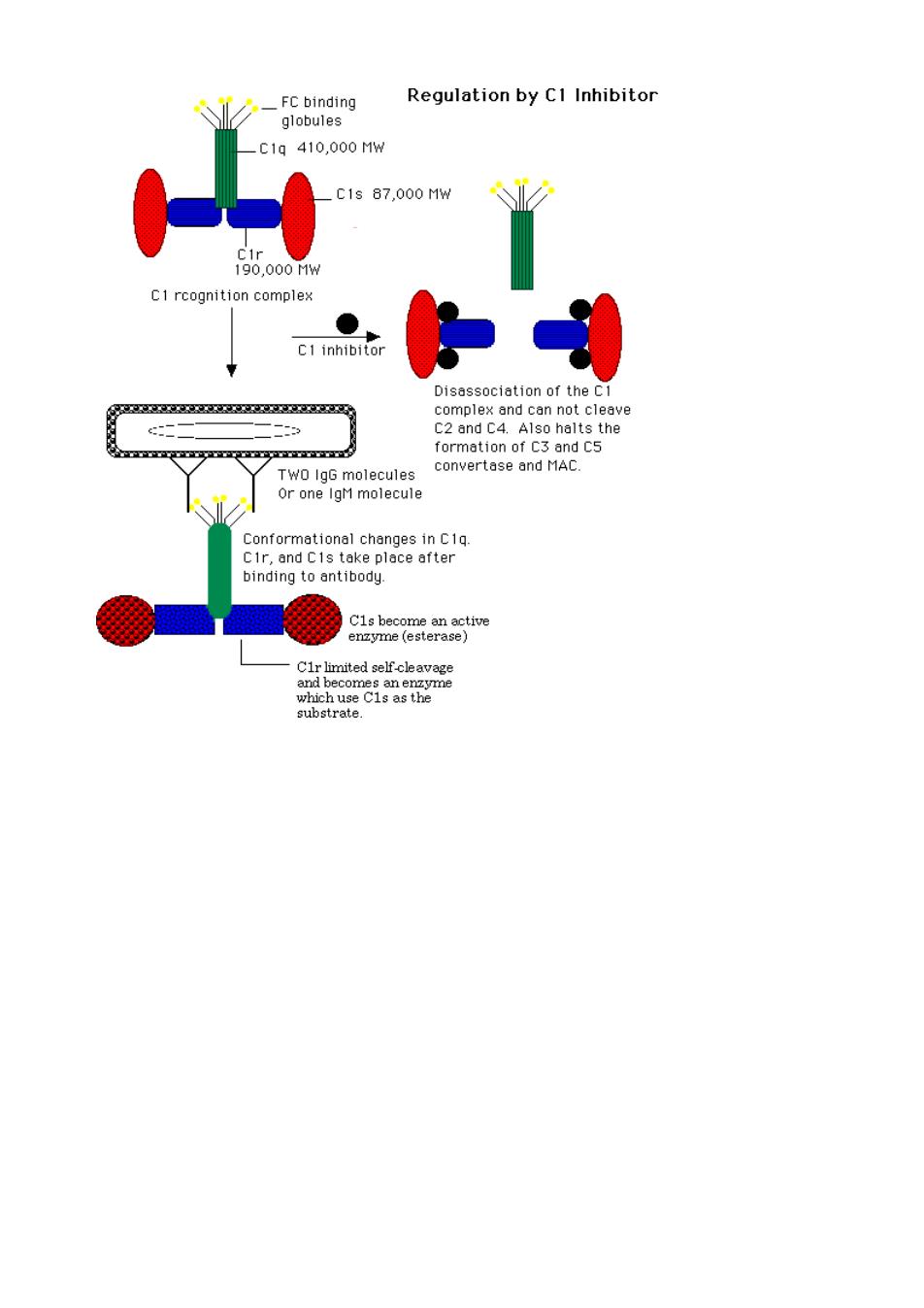
-FC binding Regulation by CI Inhibitor globules -C1g410,000Mw _c1s87,000Mw 190,000Mw C1 rcognition complex Disassociation of the C complex and can not cleave binding to antibody. C1rlimitedfc
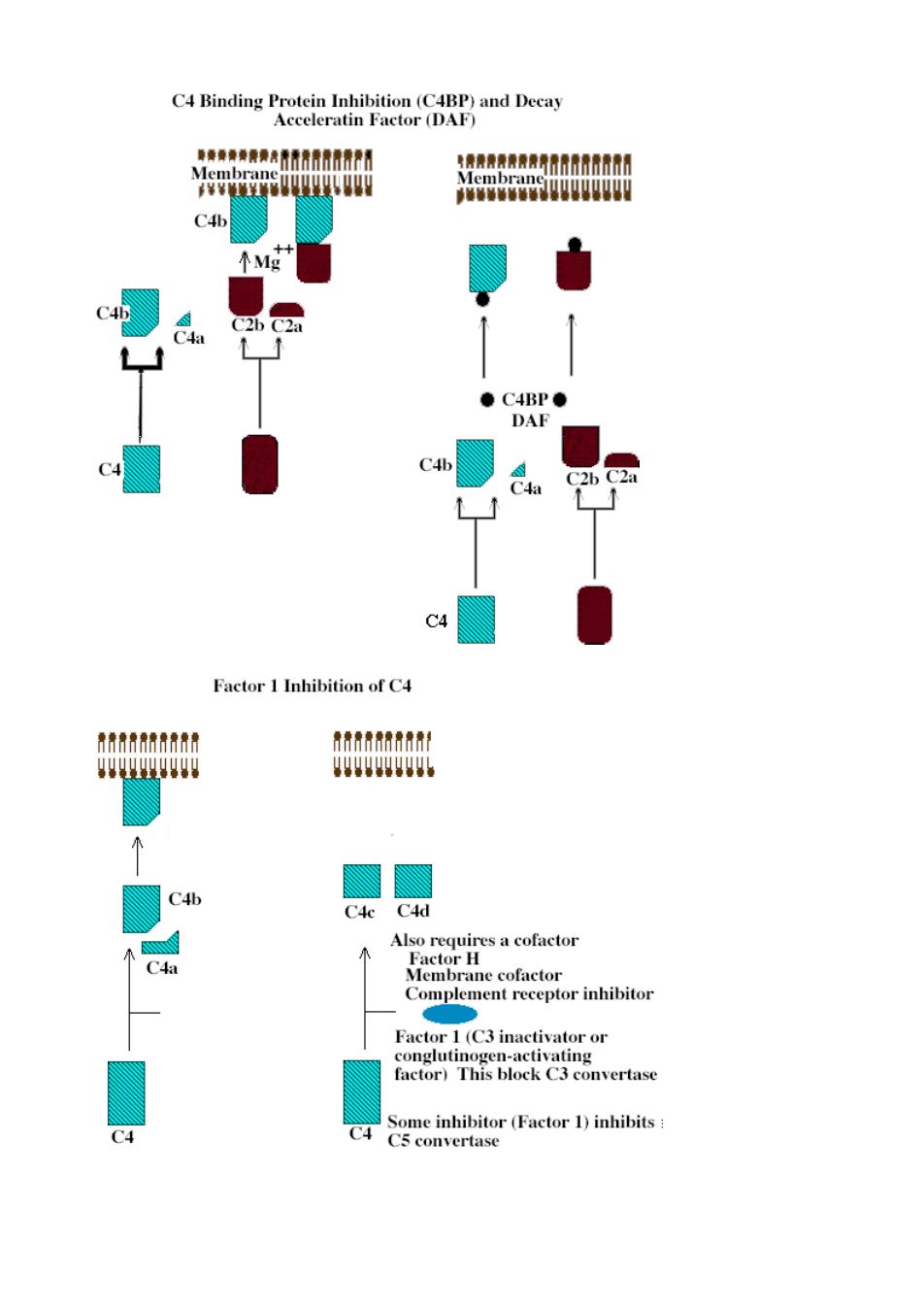
C4 Binding Protein Inhibition(C4BP)and Decay Acceleratin Factor (DAF 票要快身要特要秀质开8新质特总 AtHHi 899N99N9 C4h ●C4BP● DAI C4b C4 Factor 1 Inhibition of C4 升开开济精A行 RR精府精贵AR 9g9 999w6 C46 C4c C4d Also req es a cofactor C4a ane cofactor omplement receptor inhibito or 1(C3 inactivator or onglutino activa C4 ome inhibitor(Factor 1)inhibits C5 convertase

Factor I inhibition of C5 convertase IABBBnB8888* 典典典两青典A青青典典费费A EETTTEEEE 9 C4b C4b C3b C3b C3b C2b C2b Factor 1 inhibitor.same Cabapaprtase Capsrase The classical complement cascade must be carefully regulated.The series of events must be of limited duration in order to prevent the complete consumption of inactive complement components in the serum.Each stage in this pathway contains regulatory proteins. The first stage of complement activation is the formation of recognition complex,CI.Cl inhibitor is responsible for the inactivation of Cl.Its main function is to combine with activate Cl by binding to sites of CIr and Cls,causing these subunits to dissociate from Ab-bound Clq. The inactivation of c3/C5 convertase is accomplished in two stages.The first stage t by dissociation of C2 from cell- bound C4.This is done by CBP)and decay-accoleratimg factor (DAP).In the seond stare the generation of C3 convertase is blocked.This occurs through the further degradation of C4b into the inactive fragments C4c and C4d,and also by the cleavage enzyme,Factor I.Factor I requires a cofactor,these may be factor H and CRI
The classical complement cascade must be carefully regulated. The series of events must be of limited duration in order to prevent the complete consumption of inactive complement components in the serum. Each stage in this pathway contains regulatory proteins. The first stage of complement activation is the formation of recognition complex, C1. C1 inhibitor is responsible for the inactivation of C1. Its main function is to combine with activate C1 by binding to sites of C1r and C1s, causing these subunits to dissociate from Ab-bound C1q. The inactivation of C3/C5 convertase is accomplished in two stages. The first stage consists of activity lost by dissociation of C2 from cell-bound C4. This is done by C4-binding protein (C4BP) and decay-accelerating factor (DAF). In the second stage, the generation of C3 convertase is blocked. This occurs through the further degradation of C4b into the inactive fragments C4c and C4d, and also by the cleavage enzyme, Factor I. Factor I requires a cofactor, these may be factor H and CRI
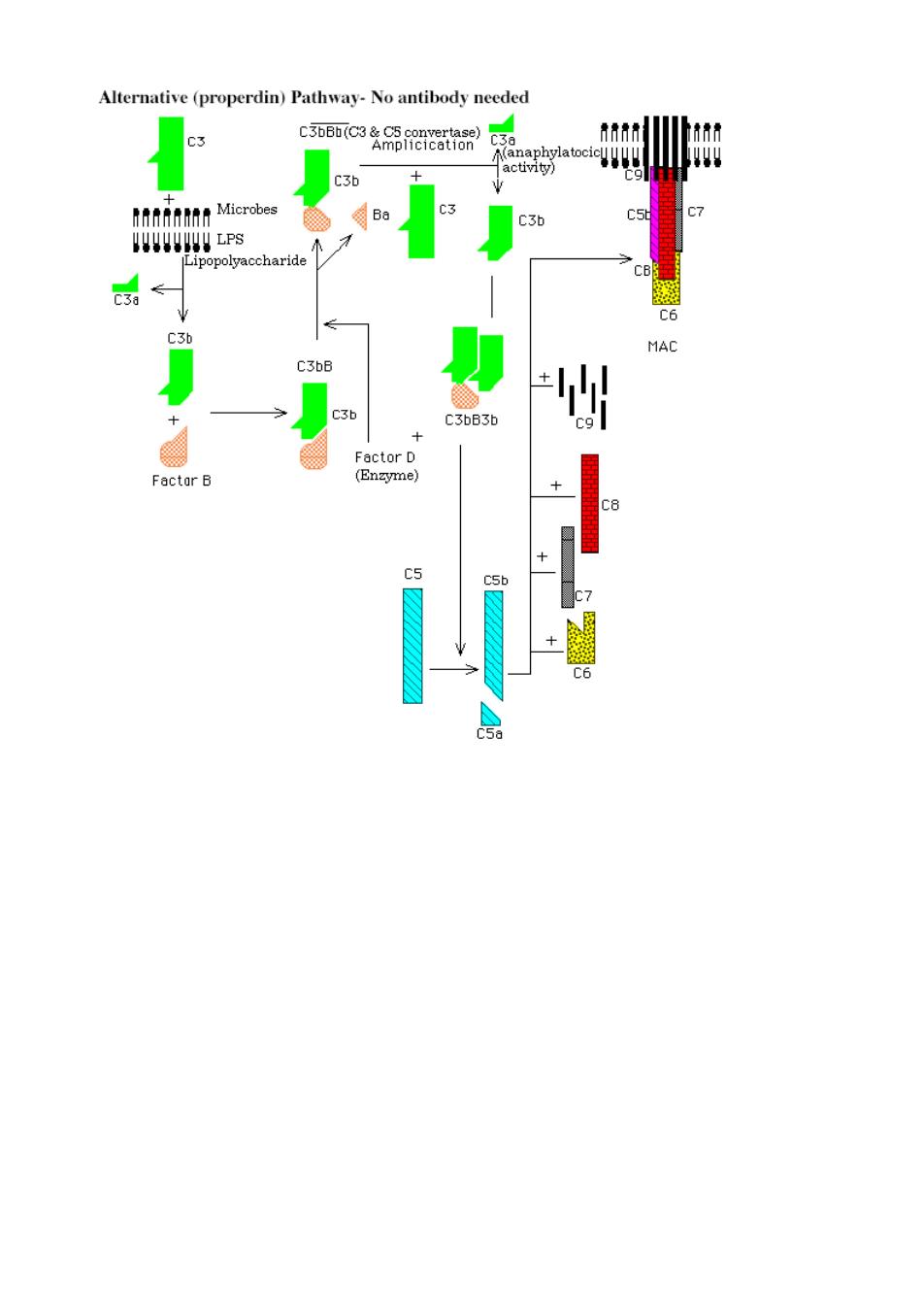
Alternative(properdin)Pathway-No antibody needed c3 c306c34隔89 C3h Microbes WUUUUUWU LPS c6 MAC Factor D Factor B Enzyme

Regulation of the Properdin Pathway Positive surtace Regulation Negative regulation R开开开R开 99W9 C3 Factor1 Factar Mg2+Blocks access to C3t -Factor H dissociation of C3bBb Factor D_ Ba roperdin C3+b C33 Activation C5 and promotes formation of MAC Alternative or Properdin Pathway The alternative or properdin pathway can be initiated with the complete absence of antibodies.This pathway can be activated by nonimmune activators for example repeating polysaccharide unitsor the LPS found on the cel was of some microbes This alternative pathway differs from the classical pathway in that it has substitutes for the early acting Cl,C4,and C2 components.Therefore,it can directly initiate the reactions of the late-acting C3-C9 components.It also differs in that it provides an immediate line of defense that does not require immunological memory. This pathway is characterized by a two-phase system in which six proteins participate Initiation is the first phase,particle-bound C3b acts like the Cl recognition complex The second phase is called amplification,driven by a positive feedback loop involving bound C3b,Factor B,and Factor D. Initiation Phase.C3 is a two-chain molecule,which upon cleavage,a highly reactive it might bind.If the acceptor surfaces are chemically suitable,interaction with
Alternative or Properdin Pathway The alternative or properdin pathway can be initiated with the complete absence of antibodies. This pathway can be activated by nonimmune activators, for example, repeating polysaccharide units or the LPS found on the cell walls of some microbes. This alternative pathway differs from the classical pathway in that it has substitutes for the early acting C1, C4, and C2 components. Therefore, it can directly initiate the reactions of the late-acting C3-C9 components. It also differs in that it provides an immediate line of defense that does not require immunological memory. This pathway is characterized by a two-phase system in which six proteins participate. Initiation is the first phase, particle-bound C3b acts like the C1 recognition complex. The second phase is called amplification, driven by a positive feedback loop involving bound C3b, Factor B, and Factor D. Initiation Phase. C3 is a two-chain molecule, which upon cleavage, a highly reactive thiol-ester group is exposed on the C3b fragment. This reactive group could be attacked by water, by the surface of an organism, or by foreign substances to which it might bind. If the acceptor surfaces are chemically suitable, interaction with